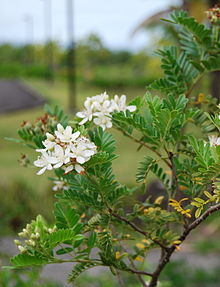- Osteomeles anthyllidifolia
-
Osteomeles anthyllidifolia 
Scientific classification Kingdom: Plantae (unranked): Angiosperms (unranked): Eudicots (unranked): Rosids Order: Rosales Family: Rosaceae Genus: Osteomeles Species: O. anthyllidifolia Binomial name Osteomeles anthyllidifolia
(Sm.) Lindl.[1]Osteomeles anthyllidifolia, commonly called ʻŪlei, Eluehe, Uʻulei, Hawaiian Rose, or Hawaiian Hawthorn, is a species of flowering shrub in the rose family, Rosaceae, that is indigenous to Hawaiʻi (all islands but Kahoʻolawe and Niʻihau), the Cook Islands, Tonga, Rarotonga, Pitcairn Island, and Rapa Iti.[2]
Contents
Description
Osteomeles anthyllidifolia grows as either an erect shrub that reaches 3 metres (9.8 ft) or a spreading shrub. The compound leaves are alternately arranged on branches and divided into 15-25 leaflets. The small, oblong leaflets are 1.5 centimetres (0.59 in) long and 0.7 centimetres (0.28 in) wide. White flowers with five 7–11-millimetre (0.28–0.43 in) petals form clusters of three to six on the ends of branches. The fruit is white when ripe, 1.0 centimetre (0.39 in) in diameter, and contains yellow seeds that are 1.5 millimetres (0.059 in) in diameter.[2]
Habitat
Osteomeles anthyllidifolia can be found in dry to mesic forests, shrublands, coastal areas, and lava plains at elevations of 2–2,320 metres (6.6–7,610 ft).[3] It is a ruderal species, able to effectively compete with other plants on disturbed sites.[4]
Uses
Medicinal
The leaves and root bark are used on deep cuts; the seeds and buds are used as a laxative for children.[5]
Non-medicinal
The wood of a mature Osteomeles anthyllidifolia is very strong, and Native Hawaiians used it to make ke ʻō (harpoons) with which they caught heʻe (octopuses).[6] Ihe paheʻe (javelins), ihe (spears), ʻōʻō (digging sticks),[3] hohoa (round kapa beaters) ʻiʻe kūkū (square kapa beaters), ʻūkēkē (musical bows), and ʻauamo (carrying sticks) were also made from the wood. Young, flexible O. anthyllidifolia branches were fashioned into the hoops of ʻaʻei. These were 25-foot (7.6 m) bag nets that were used in conjunction with kalo (taro) as bait to catch schools of ʻōpelu (Decapterus macarellus).[7] The fruit is edible and was used to make a lavender dye.[3]
References
- ^ "Osteomeles anthyllidifolia (Sm.) Lindl.". Germplasm Resources Information Network. United States Department of Agriculture. 2008-09-28. http://www.ars-grin.gov/cgi-bin/npgs/html/taxon.pl?456829. Retrieved 2009-03-05.
- ^ a b "Osteomeles anthyllidifolia (Rosaceae)". Meet the Plants. National Tropical Botanical Garden. http://www.ntbg.org/plants/plant_details.php?plantid=11894. Retrieved 2009-03-05.
- ^ a b c "ʻulei, uulei, eluehe (Molokai)". Hawaiian Ethnobotany Online Database. Bernice P. Bishop Museum. http://www2.bishopmuseum.org/ethnobotanydb/resultsdetailed.asp?search=ulei. Retrieved 2009-03-05.
- ^ "Osteomeles anthyllidifolia". Hawaiian Native Plant Propagation Database. University of Hawaiʻi at Mānoa. http://www2.hawaii.edu/~eherring/hawnprop/ost-anth.htm. Retrieved 2009-03-05.
- ^ Akana, Akaiko (1922). Hawaiian Herbs of Medicinal Value. Honolulu, Hawaiʻi: Pacific Book House. p. 38.
- ^ Krauss, Beatrice H. (1993). Plants in Hawaiian Culture. University of Hawaiʻi Press. p. 45. ISBN 9780824812256. http://books.google.com/?id=WOdrGIP3zksC.
- ^ Medeiros, A. C.; C.F. Davenport; C.G. Chimera (1998) (PDF). Auwahi: Ethnobotany of a Hawaiian Dryland Forest. Cooperative National Park Resources Studies Unit, University of Hawaiʻi at Mānoa. http://www.hear.org/naturalareas/auwahi/ethnobotany_of_auwahi.pdf.
Categories:- Flora of Polynesia
- Flora of Hawaii
- Ruderal species
- Rosaceae
Wikimedia Foundation. 2010.
